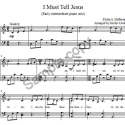Posts Tagged ‘church pianist’
Wednesday, August 9th, 2017
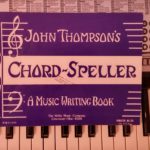
Need to brush up on chord theory?
I have a chord speller book by John Thompson that I use to teach my church pianist students who need to brush up on theory.
This book provides foundational information needed for the church pianist to effectively improvise.
Short synopsis of book:
John Thompson’s Chord-Speller
The purpose of this book is to present the Triads (including the Dominant and Diminished Seventh Chords) in a way that will enable the student to read them, write them and recognize them by sight or sound.
Having a working knowledge of scale and chord structure will help the church pianist with improvising hymns.
If you’re interested in seeing sample pages or purchasing the book…just click on the image of the book above.
I’m always looking for simple-approach type books and this one fits the bill! (I don’t get paid to sell this book) 🙂
This book has been around for awhile so you may find it on Ebay or Amazon.
Tags: chord theory, Chords, church pianist, jenifer cook, john thompson's chord speller
Posted in Chords, Important Information, Improvising hymns, Theory | No Comments »
Monday, July 24th, 2017
So many times I have wanted to play “A Passion for Souls” for the invitation but not many people know this song…at least not in our church. The melody is ok but felt like it needed a face-lift.
I like to play familiar songs during invitation…hymns that the people know since I play background music during invitation. (I miss the days of hearing the congregation sing during invitation).
Back to topic! I thought…if I could re-work the melody on this song…maybe it would revive a long lost hymn…at least for our church 🙂
So…a new melody to “A Passion for Souls” flowed out of my mind during a recent spurt of inspiration last week. Hope the song is a blessing to you.
I’m singing it as a duet with a friend this Sunday morning. (The arrangement can either be a duet or solo) I’ll share a video of the duet asap.
Here’s a sampling of sheet music for “A Passion for Souls” which I will publish next week. (Click on image below for larger view)
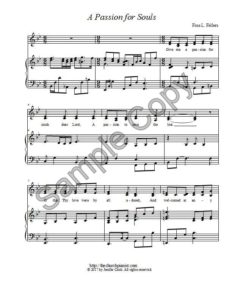
Tags: a passion for souls, church pianist, invitation, jenifer cook, mission's song
Posted in Music Store, Special Music, Vocal | No Comments »
Saturday, July 22nd, 2017

Every now and then I have a splurge of music ideas run through my head. Last week was one of those times. The results: an early intermediate piano arrangement of “I Must Tell Jesus” and a new melody for an old hymn “A Passion for Souls”. (Here’s a sample of the new tune)
A Passion for Souls
At the time of my overwhelming inspiration, I was in final editing stage on “Jesus Paid it All” ladies two-part arrangement, “Nearer My God to Thee” adding violin bow marks….thanks to help from one one of my violin friends… Abby Phillips AND an updated version of my advanced piano arrangement of “Abide With Me” written as I performed for the recent Composer’s Symposium.
Just so you know…silence doesn’t mean I’m not writing 🙂
Tags: a passion for souls, church pianist, jenifer cook
Posted in Important Information | No Comments »
Friday, July 21st, 2017
Modulating between hymns during a prelude or other background music event can create a seamless presentation.
The absence of this art makes for a disjointed sound when going from hymn to hymn. (unless of course the songs are in the same key) 🙂
Ah….but just because the songs are in identical keys doesn’t mean the songs will always sound seamless without some type of transition. (another lesson!)
Every church pianist should try and learn the art of modulation to the best of his or her ability…in small bits at at time. For starters, learn to modulate between songs with same time signature as I have provided below. (The modulations will feel/flow a little different in 3/4 time versus 4/4 time.)
Below is a free pdf showing how to modulate up a fifth using the chord formula: ii7 to V7 of the new key. I’ve also shared a list of these two chords in the keys found on the free pdf of modulations.
Key of C
ii7 = D-F-A-C
V7 = G-B-D-F
Key of G *see visual of these 2 chords HERE
ii7=A-C-E-G
V7= D-F sharp-A-C
Key of D
ii7= E-G-B-D
V7= A-C sharp-E-G
Modulating up a Fifth Free PDF
Tags: church pianist, hymn, jenifer cook, modulation
Posted in Free music, Miscellaneous tips, Modulation, Theory | No Comments »
Wednesday, July 19th, 2017
One of my former piano students approached me at church a couple months ago and asked if I would write her an offertory arrangement of “I Must Tell Jesus”.
Well…I finally got around to it! 🙂 But what a surprise! This arrangement just flowed out of my little brain this week and I quickly penned it to paper. It’s not always that easy for me to arrange a hymn!
I tried to arrange this piano solo well within her early intermediate level…hoping she could learn it soon. Even though I’m an advanced pianist…I wouldn’t mind playing this for offertory.
Early intermediate sacred piano solo, 2 pgs. Approx. length 1:24
Price: $3.00
Tags: church pianist, early intermediate piano solo, i must tell jesus, jenifer cook, pianist
Posted in Music Store, Offertories, Special Music | No Comments »
Monday, July 17th, 2017

Introduction
Modulating during any type of prelude (church, funeral, wedding or other occasion)…creates a smooth transition between songs. Without a smooth transition between different keys, the music will sound interrupted or very abrupt. The articles associated with this lesson and future lessons will deal with modulating to a higher key. Modulating to a lower key can also be effective but such a topic belongs in a different set of lessons.
The modulation chord formula that works for most any key change uses the ii7 to V7 chords of the new key.
(I personally like to use the V7 sus instead of a plain V7…but will will illustrate at the appropriate time).
*Part two will provide a FREE pdf with several examples of modulating up a fifth. (C Major to G Major)
Keyboard visuals of the ii7 & V7 chords in the key of G Major are shown below. (The upcoming examples will cover C to G, G to D and F to C using this chord formula)
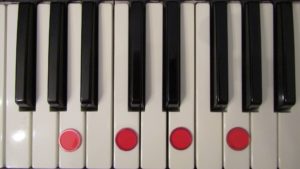
ii7 of G Major
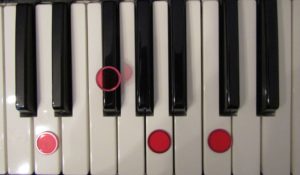
V7 of G Major
Working on the examples now and hope to share this week!
Tags: church pianist, jenifer cook, modulating, modulations
Posted in Accompaniment tips, Chords, Miscellaneous tips, Modulation, Theory | No Comments »
Friday, July 14th, 2017

Do modulation and transposition mean the same thing? They ARE closely related but describe two different actions.
Modulation is the transition process (the key change itself)… that takes the pianist to the new key.
Transposition is playing a song in a different key than what’s written.
Next post will share a modulation chord that is commonly used for modulating from one key to another.
Tags: church pianist, jenifer cook, modulation transposition, pianist
Posted in Important Information, Modulation, Theory, transposing hymns | No Comments »
Saturday, June 24th, 2017
Thanks for the feedback on how to present Easy-2-Play Congregational Hymns!
How about this look for Easy-2-Play Congregational Hymns?
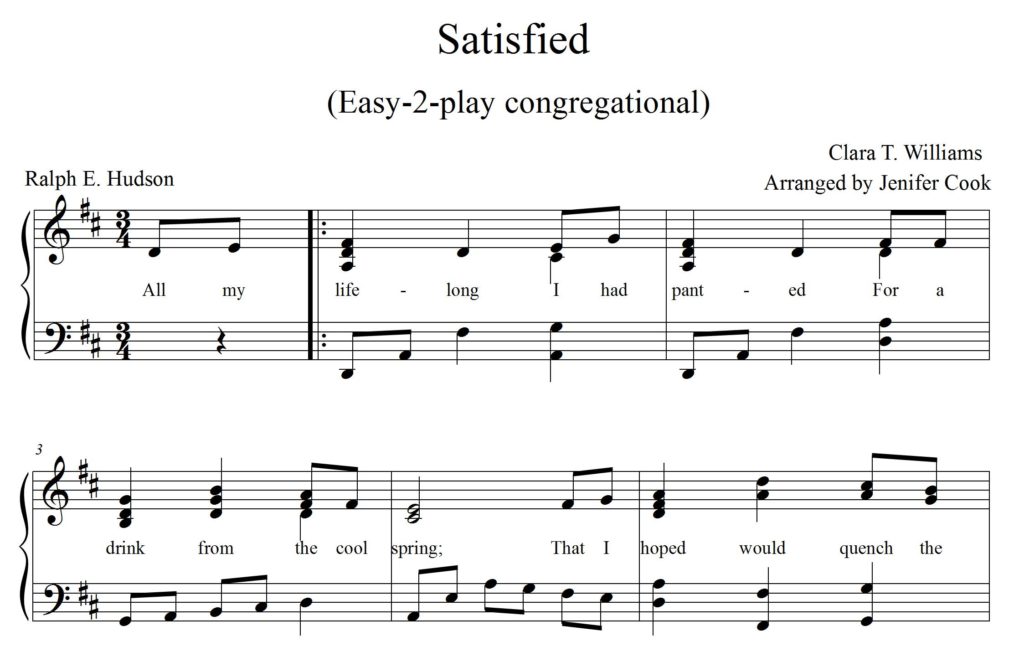
Tags: church pianist, congregational hymns, easy-2-play-congregational-hymns, jenifer cook
Posted in congregational singing | 4 Comments »
Thursday, June 22nd, 2017
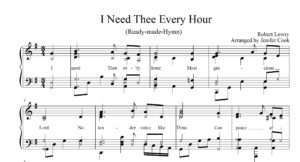
This post is in reference to yesterday’s article about Ready-Made-Hymns.
How do you like this look? The “x” marks indicate original notes to help the church pianist see what note changes were made.
Is this beneficial to you? Feedback would be appreciated! Thanks for all the comments yesterday! Very helpful! 🙂
Just click on the following image to enlarge for easier viewing.
*Special note: THANKS for the feedback! After reading the comments here and on facebook….I will be putting these type of easy-to-play congregationals into print instead of by hand. I will do away with the original notes from the hymnbook and ONLY type in my (hopefully) easy-to-play congregational/piano solo arrangement. Thanks again for your helpful comments!
Tags: church pianist, jenifer cook, ready made hymns
Posted in Important Information | 2 Comments »
Wednesday, June 21st, 2017
For the past couple of months…I’ve been creating “ready-made’ hymn arrangements for some of my church pianist students who are need of improvised hymns for congregational singing. (Can also be used as piano solo)
These hymn arrangements are nothing more than a copy of a hymn from the hymnal with my added improvised notes in red.
Just curious, would this meet the need for others as well? I’m considering adding them to our online music store if there’s enough interest.
The cost would be less than my regular “printed arrangements”.
Here’s a FREE copy of one of these ready-made hymn arrangements. (Also trying to decide what to call them….any suggestions?)
*Also…are you all ok with it being handwritten just as it appears in free arrangement below?
*Special note: THANKS for the feedback! After reading the comments here and on facebook….I will be putting these type of easy-to-play congregationals into print instead of by hand. I will do away with the original notes from the hymnbook and ONLY type in my (hopefully) easy-to-play congregational/piano solo arrangement. Thanks again for your helpful comments! I do have (more involved ) congregational piano arrangements for sale HERE.
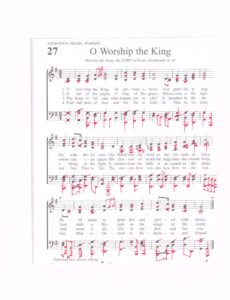
Ready-Made Hymns for the Church Pianist
Tags: church pianist, jenifer cook, ready made hymn arrangements
Posted in Accompaniment tips, Choir, congregational singing, Free music, Miscellaneous tips, Offertories, Special Music, Vocal | 13 Comments »



